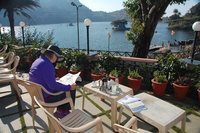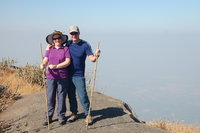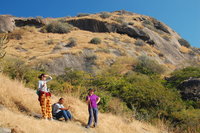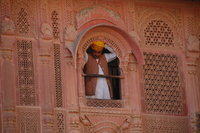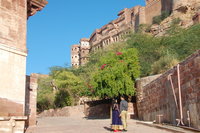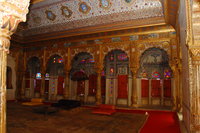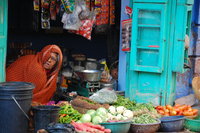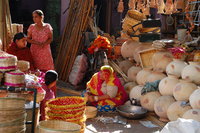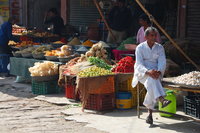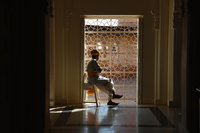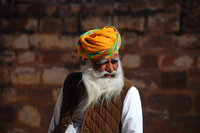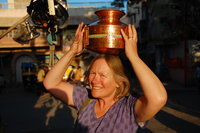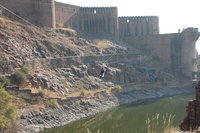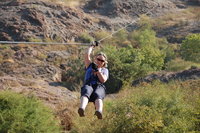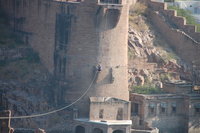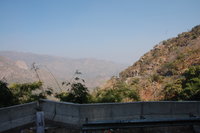
We departed Udaipur on a private bus to Mt Abu. Up to now, when not using the train, we had travelled on government buses and found them to be cheap, punctual and reliable; although they seem to be frowned upon by those Indians who can afford not to use them. The private buses claim to be more comfortable, more reliable and quicker than the government ones. Of course, in reality they are none of these things. Since they are run at a profit, and are not bound by a published schedule, they refuse to depart until they are full and even then will stop to pick up along the way since the driver can make a bit on the side. Our bus was scheduled to depart at 8am. At 8:30, after much shouting and gesticulating, we set off...in the wrong direction. We went about a mile, did a u-turn and returned to stop about 100m from where we had got on, where we sat for another half an hour. These kind of antics will be familiar to anyone who has travelled by bus in the more "emerging" countries.
Of the total 213km (4 hours), the final 26km of our bus trip was up into the Aravali mountains to get to Mt Abu. The scenery was spectacular and the road winding and rather precipitous. We were reminded of our hair-raising travels around Peru last year, although there were some important differences, namely: the bus was only doing 9mph not 90, the roads are tarmac not gravel, there is a concrete barrier along the edge as opposed to a few weeds and lastly, the drop was not 3km straight down! In Steve's book, this made for a much more relaxed ascent although Megan felt it was more dicey than South America.
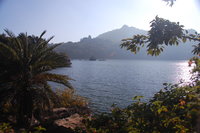
Mt Abu was the only hill-station in Rajasthan and still is its highest point (a local peak reaches a rather unimpressive 1722m). These days, it is not so much a hill station as a tourist resort favoured by holidaying Gujaratis and honeymooners. In the hot, summer season coming up here provides a respite from the sweltering temperatures on the plains. At this time of year, in winter, it is a very pleasant 25°C during the day, but it is only about 5°C at night due to a stiff northerly off the Himalayas. Nevertheless, the place is rammed with Indian tourists who come here to take pedalos out on Nakki Lake, eat ice cream and photograph themselves at every opportunity - preferably with us in shot somewhere! Oh, they also come here to drink, since Gujarat is a dry state (Steve was reminded of Saudis holidaying in Jordan). The entire area only has 20,000 inhabitants with only about 13,000 in the town itself, but there must be three times this number in tourists. Everything is rather kitsch and designed for these tourists. The local official tourist brochure states, with no sense of irony, that "you can rent a paddle boat or gondola, eat ice-cream, ride ponies or shop for tacky souvenirs". In true Hindu style, everyone is laughing and very jolly and having a good time - which we found endearing and rather infectious. Certainly the fresh air and relative tranquillity provided a very welcome respite.
We stayed in the "Hotel Lake Palace" right on the side of the Nakki Lake. Now, if you have been paying attention so far, you will know that we have been visiting palaces along the way and that many of them are derelict or certainly rather neglected. As such, we felt that calling this hotel a Palace was quite apt, but maybe not in the way the owners intended. Enough said! The hotel brochure helpfully informs us that the restaurant will only serve food that they actually have (which we really can't hold against them). On the up-side, it also states that breakfast will be served from 7am to 11am and also from 3pm to 7pm, which is handy.
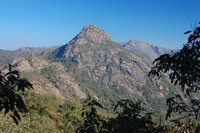
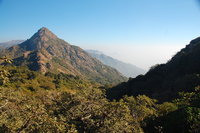
Rather than the ice-creams and pedalos, we actually came here to get away from the smog, cow excrement and rickshaws and to do a bit of walking. We contacted local guide "Mr Charles", who took us out walking in the surrounding mountains. In addition to the guiding service, he also provided free entertainment. He does a very good impression of a Frenchman speaking English; which is pretty impressive for an Indian! He also told us about the time one of his clients was mauled by a bear, oblivious to the PR disaster this could be for his business. It is always good to have an opportunity to speak with someone who has a very good grasp of English as we can then ask nuanced questions about some of the things that have been puzzling us like how the caste system works or why Indians are incapable of perceiving danger. Charles also knows a great deal about the flora and fauna of the area and made every effort to point out interesting stuff. For some reason, he had decided we were avid bird-watchers. Unfortunately, the weather was quite hazy so it's difficult to show any decent views of the mountains, so sorry to those who actually requested that.
We spent two enjoyable days hiking with Charles. His enthusiasm was infectious and his views on Buddhism and how to interact with nature quite enlightening. He also had some interesting opinions on why India is the way it is. Suffice to say he prefers to work with foreign clients rather than indigenous ones. Other than the hiking, we spent time wandering the town and its markets and staring at the tourists as much as they stared at us (which made a change). The papers are saying the area is in the grip of a particularly cold spell (due to that strong northerly) and it certainly was chilly here, but this did not seem to hinder the ice-cream sales and at least it justifies our lugging thermals around with us!
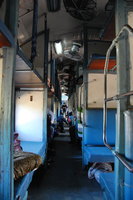
The train to Jodhpur took about 5 hours and cost the usual £1.50 each. So far, we have been travelling third class sleeper. Even though it is third class, you still have to reserve a seat in advance and, if your journey is over night, you get to use the allocated bed. During the day, the beds convert into seats and then many more seats are sold than there are beds. We have asked people how this is supposed to work since some people elect to sleep during the day, which results in insufficient seats. The common wisdom was that everyone (being Hindu) will cooperate to ensure no one is left without a seat. We still did not fully understand how this could work. On the journey to Jodhpur, we came across a group of locals who also did not seem to agree on the system and a lively debate ensued. It has to be said that it was no more than a few raised voices and after a while they all seemed to be best friends. We are still none the wiser.
So, let's get this over right away. Yes, the trousers do come from here. There is an Indian trouser called the Churidar and it was introduced to the UK at the end of the 19th century by the son of the Maharaja of Jodhpur who brought them over along with his entire polo team. It is thought that they caught on in Blighty principally because the Rajasthani polo team won so many of its matches.
Our arrival in Jodhpur was marred slightly by some confusion over the rickshaw destination that resulted in us being dumped in some dark lane in an area devoid of any accommodation - not just of ours. After a fruitless wander for a few minutes and realising we were completely lost, we phoned the guest house and then had to ask a local who we found in the street to describe to them where we were. A man was then dispatched on a moped to come and find us. Being a moped rider, he was in a permanent hurry, so he would describe our route up to the next corner and then whiz off at top speed. Once we had navigated the dark lanes and snarling dogs, he would be waiting at said corner with our next set of directions. Eventually we found the Hare Krishna Guest House and our host Mr Poonam was most apologetic about the mix-up. All's well that ends well and we finished the day at about 11pm with a delicious curry in the rooftop restaurant discussing politics with Mr Poonam overlooked by...you guessed it, Jodhpur's fort!
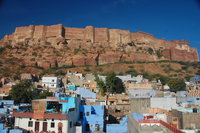
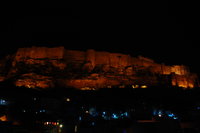
Now, this particular fort is regarded as the most spectacular in the whole of Rajasthan (of course) and is supposed to be one of the largest in India. It is called Mehrangarh which sort of means "The Citadel of The Sun". Other than some bits of old rope that we'll talk about later, this fort is the number one attraction in Jodhpur, so we had to visit it...and tell you about it...sorry!
Mehrangarh sits 120m above the old town and glares imposingly down upon it. Construction began in the mid-fifteenth century and it has been expanded and modified ever since. The ramparts make use of the natural cliff-faces and, in some parts, are built on rocky overhangs just to make them seem even more infeasible. This is the only fort in Rajasthan never to have been taken by force and this comes as no surprise when viewing the imposing battlements lined with cannon. The palace within has been restored rather well with funding from the present Maharaja of Jodhpur and contains a surprisingly good collection of memorabilia from times past that gives a good insight into the lives of the royalty. Many of the rooms have been restored to their original opulence; which is rather impressive.
The Maharaja today lives in another palace called the Umaid Bhawan on the far side of town that looks somewhat like the Taj Mahal (only pink). Unlike the Taj, it is also a hotel and is claimed to be one of the best in the world. However, rooms are reputed to be around US$1000 per night so we are unable to verify this claim. What we did discover, whilst marvelling over the excellent quality of the food in the £10 per night Hare Krishna Guest House, is that our chef is on temporary secondment from the Umaid Bhawan. In this inexpensive travellers' guest house, we have enjoyed the best food of the trip so far. According to Mr Poonam, his regular staff are all Nepalese and he let them go back to Nepal to visit family. They have not returned. Currently, he has stand-in staff who are also Nepalese. They are very cheerful and friendly, but a bit disorganised. One night we ordered food and waited nearly an hour only to discover that the [excellent] chef had taken the night off and gone to the cinema. The hot water here is only available when someone lights a fire under the rooftop water tank. From time to time, we have had to attend to the fire ourselves if we wanted a shower as they seem to forget about it. It doesn't help that we are the only people here!
We spent a day visiting the Sardar Market centred on the famous (apparently) clock tower. This market is divided into areas that specialise in different products: leather, wooden carvings, bamboo scaffolding, that sort of thing. Of course, a large Indian market in a large Indian city is going to be colourful, noisy, dirty and, in many respects, rather unpleasant. Still, if we had wanted clean and tidy, we would have gone to Singapore! Megan declared this to be the dirtiest place we have been so far and, if judged on a count of the number of flies, then this is likely accurate. It would be fair to describe the whole market experience as "interesting". Close to the aforementioned clock tower, the sales pitch is hard and focused on the tourist, with some very well honed techniques and ruses. Further away and in the back streets, the locals go about their business largely oblivious to us.
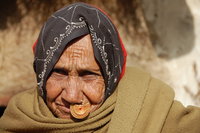
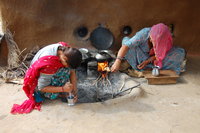
On another day, we hired a Jeep and driver to take us out to see a Bishnoi village. The Bishnoi are a strictly vegetarian, nature loving people who hold many things sacred including the Khejri tree. In the 18th century, the then Maharaja wanted a palace building (as you do) and sent workers out to collect lime for the cement. This involved them burning a lot of wood and they began harvesting trees to this end; including the Khejri. When the Bishnoi learned of this, one of the tribe's women embraced one of the trees and said they would have to cut off her head before they could cut down the tree. So they did. She was rapidly replaced by her daughters who made the same statement and who met the same end. Things escalated and, in total, 363 Bishnoi were decapitated before the Maharaja learned what was going on. He immediately stopped the process and passed a law preventing harvest of the Khejri tree. Today, there is a memorial garden planted with 363 Khejri trees. Our Rough Guide manages to be both succinct and facile in describing the Bishnoi as the original tree-huggers.
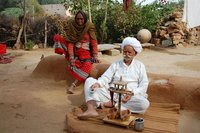
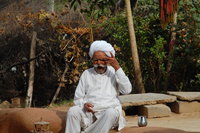
Whilst with the Bishnoi, we witnessed an opium ceremony in which the grandfather of the family cooked up some resin to make tea. He rather generously shared a few drops with us before downing the lot! Whilst this is referred to as a ceremony, it is really simply feeding an addiction that is very common amongst the (older) men. Apparently, much of the opium comes from Afghanistan (which is unsurprising really) and 1Kg of pure resin costs around 80,000 Rupees, which is about £800 - a bargain by Western standards. This quantity will last an individual about 4 years. The Bishnoi don't smoke or drink and view opium as a preferable habit and, at this price, it's hard to argue with them. The Indian government does not agree, however, and the practice is illegal, although seemingly tolerated in these isolated communities. Perhaps they feel the Bishnoi have had a rough enough deal already.
Our driver spoke pretty good English and explained much of what we were seeing and translated our questions into Bishnoi-ese for the villagers. Regarding this gentleman, there was something rather incongruous about being driven around Northern India by a Pakistani in an ex-US army Jeep!
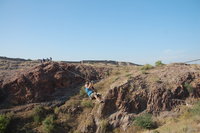
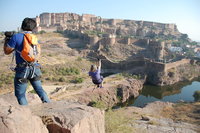
Regarding the bits of old rope mentioned earlier, Jodhpur is home to something which is billed as "Asia's Most Thrilling Aerial Adventure".This is the Flying Fox zip-wire. Actually, it is six zip wires starting in the Mehrangarh fort, soaring out over the Rao Jodha eco-park and its lakes before finally returning via the spectacular 300m wire known as the Magnificent Marwar. In total, apparently there is 1.4km of wire. Obviously, the setting is everything here and zipping away from the battlements and out over the desert, before finally returning to the fort was an attraction we could not miss. It's not hugely cheap (£13 each for the whole six zip-wire trip), but considerably less than the £60 it costs to do the one in Wales! It was jolly good fun and probably no more dicey than your average bus trip.
So, that's it for 2014. Our next instalment will come to you from the Thar Desert, somewhere around the Pakistani border (insha'Allah). In the meantime, thanks again for taking the time to read this blog and we wish you a Happy Christmas and prosperous New Year from the sub-continent.
